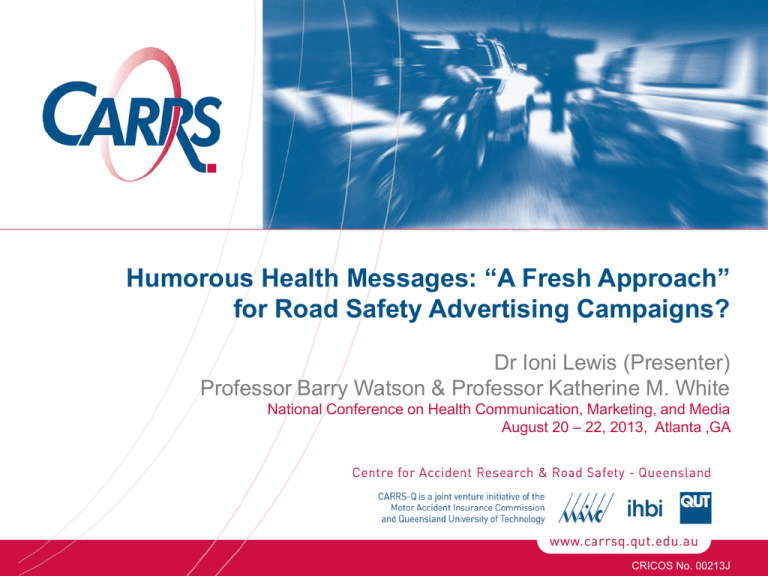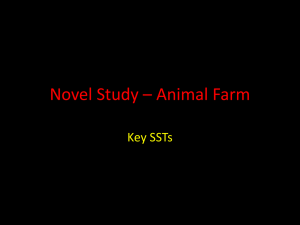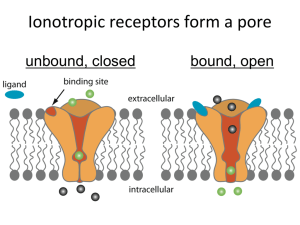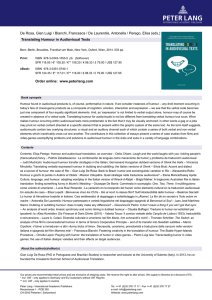Presentation (MS Powerpoint 2007 1MB)
advertisement

Humorous Health Messages: “A Fresh Approach” for Road Safety Advertising Campaigns? Dr Ioni Lewis (Presenter) Professor Barry Watson & Professor Katherine M. White National Conference on Health Communication, Marketing, and Media August 20 – 22, 2013, Atlanta ,GA CRICOS No. 00213J Presentation Overview • Background to the project – Road safety advertising, males, fear & humour • The current study - Research Questions • Method – Qualitative approach – Participants – Materials • Findings • Discussion – Summary of Key Findings – Future implications for research and practice Road Safety Advertising & Focus on Males • Road safety advertising is a key component of Australian governments’ investment in countermeasures • An often-intended target audience males (Tay, 2002; Tay & Ozanne, 2002) • Males constitute high risk road users • Relative to females (and others), males are – more likely to engage in high risk behaviours (Fleiter et al, 2006; Harré et al., 1996) – more likely to be involved in road trauma (ATSB, 2007; González-Iglesias et al., 2012) – more likely to consider themselves as “better” or “skilful” drivers (Harré et al., 2005; White et al., 2011) Road Safety Advertising & Fear-based Approaches • Fear- or threat-based messages have been common, long-standing approach in road safety advertising in Australia • Graphic consequences (e.g., crash) are shown as a result of a driver engaging in risky/illegal behaviour/s • Evidence suggests that fear-based approaches less likely to influence males (Goldenbeld et al., 2008; Lewis et al., 2007, 2008) – Males report more influence on others than self (classic third-person perception) (Lewis et al., 2007) – Less intentional change (than females) (Lewis et al., 2007) Road Safety Advertising & Positive Emotion-based Approaches • Commenced searching for alternative approaches to enhance persuasiveness • Growing body of evidence supporting the potential effectiveness of positive messages, including humorous messages for males – Males reporting more influence on self than others (reverse third-person perceptions) (e.g., Lewis et al., 2008; see also Davison, 1983) • Important emotion-based approach that requires further investigation Why further investigation into humourbased health persuasion needed? • From the fear-based literature, we know that: • There is a need to distinguish between fear as stimulus and response (stimulus = threat) (Donovan & Henley, 1997; LaTour & Rotfeld, 1997) • Threats may be physical, social, financial, psychological (Donovan & Henley, 1997) • Individuals fear different threats, to varying extents (see Dillard et al., 1996) • So, this reasoning would suggest individuals would vary in their responses to different humour-based stimuli (Catanescu & Tom, 2001; Speck, 1991) Why further investigation into humourbased health persuasion needed? • Nabi, Moyer-Gusé, and Byrne (2007, p. 51) suggest; “. . . by determining the conditions under which humor could be functional in serious contexts, its power could be harnessed to raise awareness, disseminate information, and encourage positive attitudes and behavior while simultaneously minimizing conflict, anger, and resistance.” Persuasive Effects of Humour • Much more known about humour in commercial advertising than health advertising • Increases attention (relative to a non-humorous alternative; e.g., Schoenbach, 2003; Weinberger & Gulas, 1992) • Different conceptualisations/types of humour exist (not always defined in research – which one/s is/are appropriate?) • Speck (1991) offers one conceptualisation (see also Gulas & Weinberger, 2006) Speck’s (1991) Conceptualisation of Humour • Three humour generation processes Humour Generation Process Brief Description (Speck, 1991, p.9) Incongruityresolution Surprise occurs due to presentation of information in contrast with the way an individual previously interpreted the world. Disparagement Requires some ridicule or criticism. For the ridicule to be perceived as humorous, individual must attribute the arousal to the joke’s technique or wit rather than actual attack. Arousal-safety Requires arousal for the well-being of a target character. This arousal is sedated through the presentation of a playful element, which provides a feeling of safety for the target. Speck’s (1991) Types of Humour Humour Type Humour Generation Process/es (Speck, 1991, pp. 10-16) Comic wit Simplest & decrease possible negative Incongruity-resolution reactions, such as offence (Hatzithomas et al., 2010) Arousal-safety Sentimental humour Satire Incongruity-resolution and Disparagement Sentimental comedy Incongruity-resolution and Arousal safety Full comedy Incongruity-resolution, Disparagement, and Complex & riskiest communication strategy (Hatzithomas et al., 2010, p. 61) Arousal-safety The Current Study • Understand more about the role and effectiveness of humour in health advertising addressing serious topics... • Specifically, • What types of humour can be found in road safety advertising messages? • What persuasive effects do different types of humour have in the context of road safety advertising messages? Method • Qualitative study - interviews/group discussions Participants • N = 18 (over 6 groups) licensed drivers • Males (n = 10) and females, 17-24 or 25+ yrs • Recruited on-campus or research participant panel • AUD$40 as a thank you/to cover travel & parking costs Materials • Interview schedule – (e.g., “was it humorous? why/why not?”, “would it influence you?”...) • Ads chosen (identify humour types and “all on same page” not intending to be a test of Speck’s typology) The Humorous Ads • Humorous road safety ads difficult to find • Five ads included in the study • Comic wit (x 3), Satire (x 1), Sentimental humour (x 1) [no full comedy or sentimental comedy] Comic Wit – “Karaoke” (NRMA, NSW Australia) Set in a bar with a karaoke machine and set to the song, “Peggy Sue”. The ad shows that the more people drink the more confident and loud they (and their singing) become. The voice-over explains that the more people drink the more they get false confidence. At the final stages of the ad there is a comical statement made about singing if they must after drinking because unlike driving after drinking their singing will never kill anyone. Satire – “Hangover”, TAC, Australia Two men at a bar drinking. One guy talks about the future as though it has already happened. He says that he will have too much to drink and will kill a motorcyclist on his way home and his life will end up in the toilet. Very brief visions of a crash are shown as he is talking. The other male responds, “Sweet” to which the first male replies, “Yeah, so that’s my night”. Sentimental humour – “Fine Day”, UK Dept. Transport The ad includes no voice-over and is played to an upbeat soundtrack. A motorcyclist while riding is provided various warning signs (e.g., on side of a bus, a hitchhiker’s sign). There is an element/sense that at any stage the rider might come off his bike so there is an element of arousal for the character as one watches him negotiate his ride. The rider returns home safely and tagline notes, “As if [the sorts of warnings he received in obscure places through his ride would ever really happen in the real world]”. When stepping of his bike, a bird overhead expels excrement which lands on the rider’s shoulder, implying that there just are not warnings for everything in life. Findings • Thematic analysis conducted on transcripts • Overall, key themes emerging: – Humour needs to be clever, unexpected, and in contrast with the everyday – Surprise and interest in, and support for, using humour – Caution with using humour for a serious health topic – Persuasive function/s of humorous messages • Quotes provided (with particular focus on responses from male responses given interest in examining humour as a persuasive alternative for targeting high risk road users) Findings cont... Clever, unexpected, & in contrast with the everyday “I think with humour there’s a large component of the response as it were, being unexpected. Almost like the reverse of what you think is going to happen” (M, Gp1) “Yeah it’s more than just toilet humour...It’s funnier on a high level...” (M, Gp5) Findings cont... Surprise & interest in, & support for, using humour • Prior to seeing/hearing any of the ads, participants were unable to recall a humorous road safety ad “I can’t think of any that were humorous to me. I can think of some recent road safety ads but they were quite the opposite of humorous” (M, Int2) • Motivated to know more about how it could be used “Yeah, that’s why I came along because I was thinking of wow that would actually be interesting. I don’t know how they could possibly incorporate that” (M, Gp5) Findings cont... Surprise & interest in, & support for, using humour • But... there was hesitation/concern at the use of humour “Initially I thought gee they would want to be careful because humour, people may not take it seriously” (M, Gp6) • Support for use (and relative to fear-based approaches) by males for males “But at the same time I think it would be useful as well [to use humour] because scare tactics only work so much before you actually, I tend to start blocking them out” (M, Gp3) “A fresh approach” (M’s & F’s, Gp3) “That’s fantastic. Why aren’t we showing those ads here?” (M, Gp3) [in response to Comic Wit type ad] Findings cont... Caution with using humour for a serious health topic • Across groups, participants emphasised that humour should in no way be associated with serious consequences of risky behaviours, such as crashes and injury/death “If you’re focusing on the tragedy of accidents, putting humour in is probably the wrong place. But if you’re trying to show the benefits of doing the right thing then it would be the context” (M, Gp1) • “Tasteful” was used to describe one of the comic wit ads shown, suggesting a potentially appropriate humour type Findings cont... Persuasive role and outcomes of humorous messages • Greater focus (discussion) on the benefits to persuasion • Recall “I would find generally that humorous television ads I can remember... And the ones I remember I would say are the humorous ones” (M, Gp1) • Humorous ads more likely to be talked about “Yeah I think it would be the sort of thing that people would discuss down the pub, they’d be having a beer with a mate and they’d talk about that [humorous] ad” (M, Gp1) Discussion - Summary of Key Findings • Interest and support for greater use of humour in road safety advertising but... • Must be APPROPRIATE (see Lewis et al., 2007; Scott et al., 1990) • Incongruity-based theories of humour generation (i.e., comic wit, satire, sentimental comedy) (see Hatzithomas et al., 2010) • As a humour type, comic wit ads received favourable comments across the groups (although that does not mean there were not mixed views) • Support from males for the use of humour for males • Focus more on the persuasive benefits and in social media realms there is evidence to suggest humorous messaging more likely to be forwarded (shared) (see Hseish et al., 2012) Implications for Future Research & Practice • Research – Still much more work to be done (e.g., quantitative study, large N, to compare relative effectiveness of different types of humorous road safety ads) – Importance of manipulation checks – Defining humour type (comparisons across studies) • Practice – In Australia and NZ, there is evidence of greater use of positive/positive emotion-based approaches – Careful piloting/concept required to test individuals’ responses Acknowledgments • Funding for research provided by a QUT Institute of Health and Biomedical Innovation (IHBI) grant • National Roads & Motorists’ Association (NRMA) of New South Wales, Transport Accident Commission (TAC) of Victoria, Land and Transport Safety Authority (LTSA) New Zealand, UK Dept. of Transport (for use of their respective ads in the research) References ATSB. (2007). Road deaths Australia statistical summary. Canberra: Australian Transport Safety Bureau. Davison, W. P. (1983). The third-person effect in communication. Public Opinion Quarterly, 47, 1-15. Dillard, J.P., Plotnick, C.A., Godbold, L. C., Freimuth, V. S., & Edgar, T. (1996). The multiple affective outcomes of AIDS PSAs: Fear appeals do more than scare people. Communication Research, 23, 44-72. Donovan, R., & Henley, N. (1997). Negative outcomes, threats and threat appeals: Widening the conceptual framework for the study of fear and other emotions in social marketing communications. Social Marketing Quarterly, Fall, 56-67. Fleiter, J., Watson, B., Lennon, A., & Lewis, I. (2006). Significant others, who are they? Examining normative influences on speeding. In Proceedings of the Australasian Road Safety Research, Policing, and Education Conference, Gold Coast, Australia. Goldenbeld, C., Twisk, D., & Houwing, S. (2008). Effects of persuasive communication and group discussions on acceptability of anti-speeding policies for male and female drivers. Transportation Research Part F, 11(3), 207–220. González-Iglesias, B., Gómez-Fraguela, J. A., & Luengo-Martín, M. A. (2012). Driving anger and traffic violations: Gender differences. Transportation Research Part F, 15, 404-412. Gulas, C. S., & Weinberger, M. G. (2006). Humor in advertising: A comprehensive analysis. NY: M.E. Sharpe. Harré, N., Field, J., & Kirkwood, B. (1996). Gender differences and areas of common concern in the driving behaviours and attitudes of adolescents. Journal of Safety Research, 27(3), 163-173. Harré, N., Foster, S., & O’Neill, N. (2005). Self-enhancement, crash-risk optimism and the impact of safety advertisements on young drivers. British Journal of Psychology, 96, 215-230. Hatzithomas, L., Zotos, Y., & Boutsouki, C. (2010). Humor and cultural values in print advertising: A cross-cultural study. International Marketing Review, 28(1), 57-80. Hseish J-K, Hsieh, Y-C., & Tang, Y-C. (2012). Exploring the disseminating behaviors of eWOM marketing: persuasion in online video. Elect Commer Research, 12, 201-224. LaTour, M. S., & Rotfeld, H. J. (1997). There are threats and (maybe) fear-caused arousal: Theory and confusions of appeals to fear and fear arousal itself. Journal of Advertising, 26(3), 45-59. Lewis, I., Watson, B., & White, K. M. (2008). An examination of message-relevant affect in road safety messages: Should road safety advertisements aim to make us feel good or bad? Transportation Research Part F: Traffic Psychology & Behaviour, 11, 403-417. References cont... Lewis, I., Watson, B., & Tay, R. (2007). Examining the effectiveness of physical threats in road safety advertising: The role of the third-person effect, gender, and age. Transportation Research Part F, 10, 48-60. Nabi, R.L., Moyer-Gusé, E., & Byrne, S. (2007). All joking aside: A serious investigation into the persuasive effect of funny social issue messages. Communication Monographs, 74(1), 29-54. Schoenbach, K. (2003). Advertising effects: An inventory of inventories. Admap, December, 20-22. Scott, C., Klein, D. M., & Bryant, J. (1990). Consumer response to humor in advertising: A series of field studies using behavioral observation. The Journal of Consumer Research, 16, 498-501. Speck, P. S. (1991). The humorous message taxonomy: A framework for the study of humorous ads. Current Issues & Research in Advertising,13(1), 1-44. Tay, R. (2002). Exploring the effects of a road safety advertising campaign on the perceptions and intentions of the target and nontarget audiences to drink and drive. Traffic Injury Prevention, 3, 195-200. Tay, R., & Ozanne, L. (2002). Who are we scaring with high fear road safety campaigns? Asia Pacific Journal of Transport, 4, 1-12. Weinberger, M.G., & Gulas, C.S. (1992). The impact of humor in advertising: A review. Journal of Advertising, 21(4), 35-59. White, M. J., Cunningham, L. C., & Titchener, K. (2011). Young drivers’ optimism bias for accident risk and driving skill: Accountability and insight experience manipulations. Accident Analysis & Prevention, 43(4), 1309-1315. Questions/comments? i.lewis@qut.edu.au









